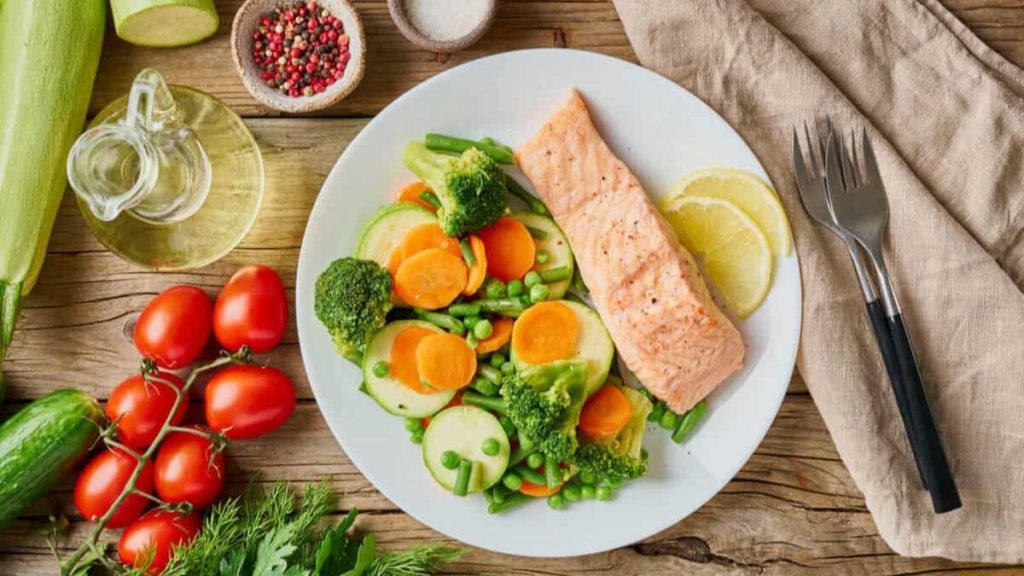The low-FODMAP diet is designed to help persons with irritable bowel syndrome (IBS) better manage their symptoms by eliminating specific foods. FODMAPs is an acronym for fermentable oligo-, di-, mono-, and polyols.
Not everyone can follow a low FODMAP diet. Most FODMAPs are prebiotics, which means they help the growth of good bacteria in the gut. If you don’t have IBS, this diet might hurt you more than helping you. If you don’t have IBS, this diet might hurt you more than helping you.
What is the Low Fodmap Diet?
FODMAP stands for fermentable oligo-, di-, mono-, and polyols. These are a group of short-chain carbohydrates that are hard to break down. These carbs have been shown to cause various digestive problems, from gas to stomach pain.
The catchy acronym stands for fermentable oligosaccharides, disaccharides, monosaccharides, and polyols, commonly called carbohydrates. These can be further broken down into five groups: fructans, galacto-oligosaccharides, lactose, excess fructose, and polyols. FODMAPs are different carbohydrates found in many foods, such as onions, garlic, mushrooms, apples, lentils, rye, and milk.
The body doesn’t well absorb these sugars They pass through the small intestine, and the body doesn’t well absorb these sugars into the colon, where bacteria ferment them. Then the gas is made, which stretches the bowel and causes pain, bloating, and wind. This can also make water move in and out of the colon, which can cause diarrhea, constipation, or both. The problems with this are more likely to happen to people with IBS.
Managing the symptoms of irritable bowel syndrome with a diet low in poorly absorbed, fermentable, short-chain carbohydrates (FODMAPs) is a successful method (IBS). Since the diet’s initial description in Australia ten years ago, it has gained popularity and is now a widely used dietary treatment method for IBS. When followed under the direction of a dietitian, the low-FODMAP diet has gained enough recognition through randomized controlled trials to be considered a first-line treatment option for IBS. Before beginning the dietary strategy, confirming the diagnosis of IBS is crucial. Therefore, the success of the diet depends heavily on the dietitian’s skill set.
Reference: https://onlinelibrary.wiley.com/doi/full/10.1111/jgh.13686
What can I Eat on the Fodmap Diet?
Foods that trigger symptoms vary from person to person.
To ease the symptoms of IBS and SIBO, it’s important to stay away from high FODMAP foods that irritate the gut, such as:
- Dairy-based milk, yogurt, and ice cream
- Wheat-based products such as cereal, bread, and crackers
- Beans and lentils
- Some vegetables, such as artichokes, asparagus, onions, and garlic
- Some fruits, such as apples, cherries, pears, and peaches
Instead, base your meals around low FODMAP foods such as:
- Eggs and meat
- Certain cheeses such as brie, Camembert, cheddar, and feta
- Almond milk
- Grains like rice, quinoa, and oats
- Vegetables like eggplant, potatoes, tomatoes, cucumbers, and zucchini
- Fruits such as grapes, oranges, strawberries, blueberries, and pineapple
Get a full list of FODMAP food from your doctor or nutritionist.
How does the Low FODMAP Diet Work?
Low FODMAP is a three-step elimination diet:
- First, you stop eating certain foods (high FODMAP foods).
- Next, you slowly reintroduce them to see which ones are troublesome.
- Once you identify the foods that cause symptoms, you can avoid or limit them while enjoying everything else worry-free.
“We suggest that you only do the elimination part of the diet for two to six weeks,” This reduces your symptoms, and if you have SIBO, it can help lower the number of bacteria in your gut that are too high. Then, add a high FODMAP food to your diet every three days to see if it worsens any symptoms. If a certain high-FODMAP food worsens your symptoms, you should avoid it for the long term.
What are the Types of Fodmaps?
Four Types of FODMAPs:
-
Oligosaccharides
Oligosaccharides come in two different types: fructans and galactans. Inulin, onions, garlic, artichokes, and wheat products all have fructans. Galatians are found in lentils, chickpeas, broccoli, beans, Brussels sprouts, and soy products.
-
Disaccharides
Lactose is the most well-known disaccharide. It is found naturally in milk and some dairy products and needs an enzyme called lactase to be absorbed. Lactose is a disaccharide in milk, yogurt, soft cheeses, ice cream, and puddings.
-
Monosaccharides
Fruits have a monosaccharide called fructose. When sources of glucose, another type of sugar, is added to fructose, it helps the body absorb it better. So, not all fruits are the same when it comes to FODMAPs. Those with the same amount of fructose and glucose might be easier to handle. Some foods high in fructose and may cause stomach problems are agave, honey, mangos, watermelon, sugar snap peas, and high fructose corn syrup. This list is not complete.
-
Polyols
Polyols are sugar alcohols found in some stone fruits, like cherries and nectarines, apples, and pears, as well as in vegetables like mushrooms and cauliflower and some sugar substitutes with xylitol or sorbitol.
What are Some Low FODMAP Meal and Snack Ideas?
- Tofu stir-fry with quinoa and Bok Choy
- Try this pan of lemon pepper fish and veggies (skip the garlic). Serve with rice and grapes for dessert.
- Beef stew served with potatoes and carrots
- Popcorn
- Fresh fruit like strawberries with lactose-free yogurt
- A handful of plain nuts or seeds like walnuts or pumpkin seeds
Is the Low FODMAP Diet Healthy?
The Low FODMAP diet isn’t meant to help you lose weight. You shouldn’t do it all without talking to a doctor first. It’s not a way to lose weight; you should only try it if your doctor tells you to. It’s not a “cleanse” or “reset,” and you should only do it if your doctor tells you to. Even though the diet may help with belching, bloating, too much gas, and diarrhea, many of the foods that aren’t allowed are some of the best choices for people trying to lose weight because they are low in calories and high in fiber. “It is not only impossible for someone to avoid all foods high in FODMAPs for a long time, but it can also lead to disordered eating and eating habits that are too limited.
Benefits of a Low FODMAP Diet
People with GI problems like Irritable Bowel Syndrome (IBS) and IBD find the low FODMAP diet very helpful. The low FODMAP diet is a temporary way of eating that cuts out grains, fruit, dairy, and sugar from your daily diet. This makes it harder for gut bacteria to find food. In the long run, this stops fermentation and helps digestive problems. Let’s take a look at what this diet might do for you:
- Improvement in the density of the endocrine cells in the large intestine: Studies show that a low FODMAP diet makes the density of the endocrine cells in IBS patients better than in healthy people. It also makes stomach pain and bloating go away.
- Improves leaky gut: The diet also improves intestinal permeability in people with IBS, which suggests that it cuts down on bacteria and helps repair the gut lining.
- Increases the amount of histamine in the body. Histamine is a signaling molecule in the gut that tells the immune system when something bad enters the body. Licking to a low FODMAP diet improves immune system markers and histamine activation.
Here’s How to Succeed in your Low-FODMAP Diet
Following a low-FODMAP diet, the tips mentioned above can be extremely useful for a healthy gut.
Get familiar with Low-and High-FODMAP Foods: To start a low FODMAP diet, you need to know which foods are low-FODMAP and high FODMAP. If you still have trouble figuring these out, you can make a FODMAP diet chart and circle the foods on the low-FODMAP list you like the most. This can also help you be creative with choosing and setting up your meal plans.
Keeping a note of food and symptoms: Another important thing to do to stick to your low FODMAP diet is to keep track of the foods you eat and the symptoms they cause. Doing this will make it easy to avoid foods that aren’t good for you and keep your digestive system healthy.
Know about the low-FODMAP servings: To keep a healthy balance of bacteria, your gut needs a wide range of nutrients. So, if you want to eat a low FODMAP diet, keep in mind the serving sizes and amounts of foods that are low, moderate, or high in FODMAPs. By doing this, you can ensure the plate is balanced at every meal and not eat too much food. It’s important, especially for people with sensitive guts, to eat well-balanced meals so that the gut doesn’t get too full of just one food. But there are some low FODMAP foods that you can eat as much as you want and others that you can’t. For example, iceberg lettuce only has low FODMAP servings, but there are no limits on how many medium or high servings it can have.
Plan your meals regularly: If you’re hungry, don’t just open your fridge and start eating right away. You could also plan out your meals. You can do this by putting stars next to the low-FODMAP foods you like best on your low-FODMAP shopping list. Everyone benefits from planning meals regularly. Everyone benefits from planning meals regularly. Everyone benefits from planning meals regularly. Everyone benefits from planning meals regularly.
- Proteins: Like lean meats, tofu, and eggs
- Vitamins and minerals: Get some vitamins and minerals from low-FODMAP vegetables and use them in salads, omelets, sandwiches, soups, etc.
- Low-FODMAP fruits: Include these in your as snacks along with corn flakes, smoothies
- Oils: You can also have olive oil, coconut oil, or safflower oil, as well as low-FODMAP nut butter, nuts, and seeds for vitamins, minerals, omega-3s, and healthy fats.
Conclusion
FODMAPs are a kind of carbohydrate that can be found in many foods. A low FODMAP diet might help you reduce your symptoms and determine which foods might make them worse if you have IBS. A low FODMAP diet can be hard to follow, so it is important to work with a dietitian who can help you through the process. There are no bad things that can happen because of the diet. But because of this, you should talk to a dietitian to ensure you get enough nutrients before starting this diet. If you avoid foods that cause IBS and eat foods that are low in fermentable carbohydrates, you can effectively treat IBS, which doctors recommend.


